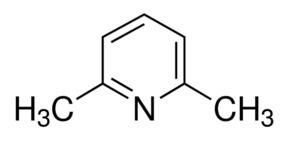Density 925 kg/m³ Molar mass 107.153 g/mol | Formula C7H9N Appearance Clear oily liquid | |
 | ||
2,6-Lutidine is a natural heterocyclic aromatic organic compound with the formula (CH3)2C5H3N. It is one of several dimethyl-substituted derivative of pyridine. It is a colorless liquid with mildly basic properties and a pungent, noxious odor.
Contents
Occurrence and production
It is produced industrially by the reaction of formaldehyde, acetaldehyde, and ammonia. It was isolated from the basic fraction of coal tar and from bone oil. It has been detected in waste water from oil shale processing sites and former creosoting facilities.
Uses
2,6-Lutidine has been evaluated for use as a food additive owing to its nutty aroma when present in solution at very low concentrations.
Due to the steric effects of the two methyl groups, 2,6-lutidine is only weakly nucleophilic. It is moderately basic, with a pKa of 6.60. In organic synthesis, 2,6-lutidine is thus sometimes used as a sterically hindered mild base.
Biodegradation
Though pyridine is an excellent source of carbon, nitrogen, and energy for certain microorganisms, methylation significantly retards degradation of the pyridine ring. 2,6-Lutidine was found to be significantly more resistant to microbiological degradation than any of the picoline isomers or 2,4-lutidine in soil. Significant volatilization loss was observed in liquid media. Estimated time for complete degradation was > 30 days.
